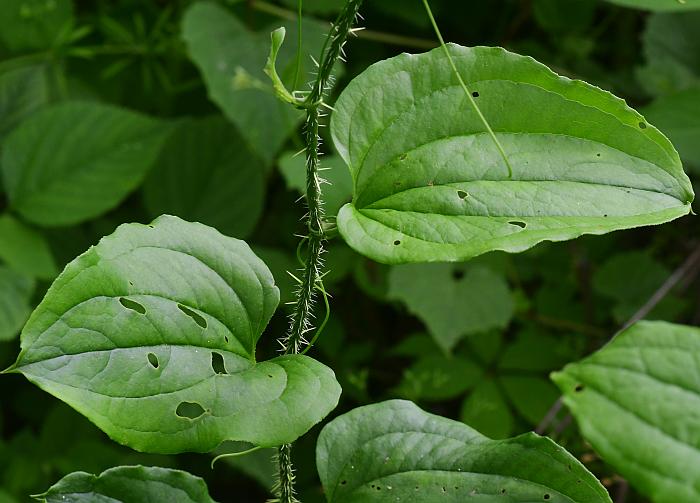Smilax hispida Raf.
Bristly Greenbrier

Native
CC = 3
CW = 0
MOC = 68
© SRTurner
Smilax hispida Raf.Bristly Greenbrier | |
 |
Native CC = 3 CW = 0 MOC = 68 |
© SRTurner |
|
Family - Smilacaceae Habit - Dioecious perennial vine, woody at base. Stems - Aerial stems to 13 m or more, circular in cross-section, sometimes with vertical lines or small ridges, climbing, green, glabrous, with spines and spinelike bristles that are dense, slender, straight, and black below, but becoming widely scattered above.
Leaves - Alternate, simple, petiolate, numerous, 5-15 cm long. Petioles shorter than the leaf blades, often with tendrils. Leaf blades narrowly to broadly ovate, the tips rounded to acuminate, sometimes cuspidate, the bases truncate to cordate, the margins not thickened, with few to numerous, irregular, minute toothlike projections, the undersurface not paler than the upper surface, green, sometimes shiny, glabrous, the primary veins arching from the base of the leaf blade and converging toward the tip, the network of smaller veins not or slightly thickened on the undersurface.
Inflorescences - Umbels arising from the axils of the upper foliage leaves of each branch, the peduncle 2-4 times as long as the petiole of the subtending leaf. Umbels mostly with 10-25 flowers.
Flowers - Perianth of 6 tepals in 2 series, these 3-5 mm long, green to yellowish green. Staminate flowers with 6 stamens, these free or fused at the filament bases. Pistillate flowers with 1 superior ovary with 3 locules, the style absent or very short, the stigmas 1 or 3, spreading.
Fruits - Berries 6-8 mm in diameter, black, not glaucous, with 1-6 seeds.
Flowering - April - May. Habitat - Mesic forests, streambanks, thickets, glades and prairie margins, fencerows. Origin - Native to the U.S. Lookalikes - S. bona-nox, S. glauca, S. rotundifolia, Dioscorea villosa. Other info. - This spiny vine is common throughout Missouri, and is found across the eastern half of the continental U.S. The vegetative plants are a common sight in forested areas, but they seem to flower only sporadically, and the flowers are small and easily missed. The spiny stems, tendrils, and broadly ovate leaves are strong clues to the identity, though these can also be present on some of the lookalikes. A key character for this species is the presence of numerous but irregular, minute projections along the leaf margins. Note that the degree of stem spininess is highly variable, depending on the plant and the portion of stem being examined. The spininess is most reliably present near the stem base and is often dark in color. Photographs taken at Weldon Spring Conservation Area, St. Charles County, MO, 9-16-2019, St. Joe State Park, St. Francois County, MO, 5-21-2020, along the Katy Trail near Marthasville, Warren County, MO, 5-24-2020, and near Labadie, Franklin County, MO, 5-21-2023 (SRTurner). |